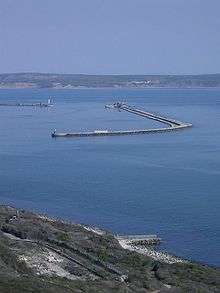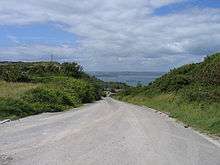HMS Osprey, Portland
HMS Osprey was an anti-submarine training establishment located at the Isle of Portland, Dorset, England. It was active between 1924 and 1941, and again from 1946 to 1999. The helicopter station RNAS Portland formed part of the establishment from 1959 to 1999.

History

With the development of anti-submarine equipment as depth charges, howitzers and hydrophones during World War I, HMS Osprey was born from the increasing need for anti-submarine training and research. The establishment at Portland was commissioned as an independent shore command and parent ship of the First Anti-Submarine Flotilla on 1 April 1924.[1][2] It was responsible for training personnel in the use of anti-submarine equipment and the development of experimental equipment, including ASDIC and later sonar.[3]
HMS Osprey moved ashore in 1927 as a shore-based establishment.[1][2] Following a major rebuild, King Edward VIII made an official visit to view the establishment in 1936.[4] Due to HM Naval Base Portland being a prime target of the Luftwaffe during World War II,[5] Osprey was transferred to Dunoon in Scotland in 1940, leaving Portland's shore-base to become HMS Attack.[6]
HMS Osprey returned to Portland in 1946 and the experimental section evolved into HM Underwater Detection Establishment (HMUDE) in 1947.[7] In 1959-60, HMUDE merged with Portland's Admiralty Gunnery Establishment to become the Admiralty Underwater Weapons Establishment (AUWE).[8] Owing to the highly classified work carried out there during the Cold War, the AUWE became the centre of worldwide attention in 1961 after the discovery of espionage infiltration. This became infamously known as the Portland Spy Ring, a Soviet spy ring that operated in England from the 1950s till 1961 when the core of the network were arrested by the British security services. 1959 also saw the commissioning of RNAS Portland (HMS Osprey), which was responsible for developing helicopters in an anti-submarine role, including the training of crews.[1]
From 1968, HMS Osprey was one of the designated locations for plan PYTHON, the plan for continuity of government in the event of nuclear war.[9] The end of the Cold War and subsequent defence budget cuts resulted in the closure of HM Naval Base Portland in 1995, as well as the AUWE research establishments, by then operated by the Defence Evaluation and Research Agency (DERA).[10] RNAS Portland's closure followed on 31 March 1999. The former air station site has now been redeveloped as an industrial and recreational site, Osprey Quay, while the HMS Osprey complex at East Weares was demolished in 2004-05 by Portland Port Ltd, the new owners and operators of the harbour.[11]
References
- Legg, Rodney (1999). Portland Encyclopaedia. Dorset Publishing Company. p. 82. ISBN 978-0948699566.
- "Why Portland's naval base was called HMS Osprey (From Dorset Echo)". Dorsetecho.co.uk. Retrieved 2015-06-23.
- "Britain's Anti-submarine Capability 1919-1939 - George Franklin - Google Books". Books.google.co.uk. Retrieved 2019-05-29.
- Morris, Stuart (1985). Portland: An Illustrated History. Dovecote Press. p. 141. ISBN 978-0946159345.
- "World War 2". Geoffkirby.co.uk. Retrieved 2015-06-23.
- Scribbles. "Royal Navy Pay and Conditions". Freepages.genealogy.rootsweb.ancestry.com. Retrieved 2015-06-23.
- https://www.gov.uk/government/uploads/system/uploads/attachment_data/file/325766/Dstl_s_history.pdf
- "Admiralty and Ministry of Defence: Underwater Weapons Establishment, later Admiralty Underwater Weapons Establishment: Reports and Technical Notes | The National Archives". Discovery.nationalarchives.gov.uk. Retrieved 2015-06-23.
- "If nuclear war had broken out between Russia and the west, HMS Osprey on Portland would have been a remote hideaway for the government". Dorset Echo. 28 January 2017.
- "A Portland Success Story | Dorset Life - The Dorset Magazine". Dorset Life. Retrieved 2015-06-23.
- "YOI and Caves on Portland, Dorset". Geoffkirby.co.uk. Retrieved 2015-06-23.